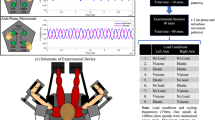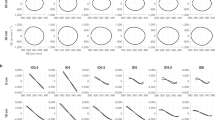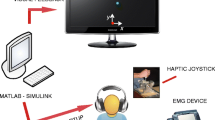Abstract
In this study we investigate the coordination between rhythmic flexion–extension (FE) and supination–pronation (SP) movements at the elbow joint-complex, while manipulating the intersegmental dynamics by means of a 2-degrees of freedom (df) robot arm. We hypothesized that constraints imposed by the structure of the neuromuscular-skeletal system would (1) result in predominant pattern(s) of coordination in the absence of interaction torques and (2) influence the capabilities of participants to exploit artificially induced interaction torques. Two experiments were conducted in which different conditions of interaction torques were applied on the SP-axis as a function of FE movements. These conditions promoted different patterns of coordination between the 2-df. Control trials conducted in the absence of interaction torques revealed that both the in-phase (supination synchronized with flexion) and the anti-phase (pronation synchronized with flexion) patterns were spontaneously established by participants. The predominance of these patterns of coordination is explained in terms of the mechanical action of bi-articular muscles acting at the elbow joint-complex, and in terms of the reflexes that link the activity of the muscles involved. Results obtained in the different conditions of interaction torques revealed that those neuromuscular-skeletal constraints either impede or favor the exploitation of intersegmental dynamics depending on the context. Interaction torques were indeed found to be exploited to a greater extent in conditions in which the profiles of interaction torques favored one of the two predominant patterns of coordination (i.e., in-phase or anti-phase) as opposed to other patterns of coordination (e.g., 90° or 270°). Those results are discussed in relation to recent studies reporting exploitation of interaction torques in the context of rhythmic movements.






Similar content being viewed by others
References
Batschelet E (1981) Circular statistics in biology. Academic, London
Barry BK, Warman GE, Carson RG (2005) Age-related differences in rapid muscle activation after rate of force development training of the elbow flexors. Exp Brain Res 162:122–132
Buchanan JJ (2004) Learning a single limb multijoint coordination pattern: the impact of a mechanical constraint on the coordination dynamics of learning and transfer. Exp Brain Res 156:39–54
Challis JH (1999) A procedure for the automatic determination of filter cut-off frequency for the processing of biomechanical data. J Appl Biomech 15:303–317
Cnockaert JC, Lensel G, Pertuzon E (1975) Relative contribution of individual muscles to the isometric contraction of a muscular group. J Biomech 8:191–197
De Rugy A, Riek S, Carson RG (2006) Neuromuscular-skeletal origins of predominant patterns of coordination in a rhythmic two-joint arm movement. J Mot Behav 38:7–14
Dounskaia NV, Swinnen SP, Walter CB, Spaepen AJ, Verschueren SM (1998) Hierarchical control of different elbow-wrist coordination patterns. Exp Brain Res 121(3):239–254
Dounskaia N, Ketcham CJ, Stelmach GE (2002a) Commonalities and differences in control of various drawing movements. Exp Brain Res 146:11–25
Dounskaia NV, Ketcham CJ, Stelmach GE (2002b) Influence of biomechanical constraints on horizontal arm movements. Motor Control 6:366–387
Ettema GJ, Styles G, Kippers V (1998) The moment arms of 23 muscles segments of the upper limb with varying elbow and forearm positions: implications for motor control. Hum Mov Sci 17:201–220
Ettema GJ, Taylor E, North JD, Kippers V (2005) Muscle synergies at the elbow in static and oscillating isometric torque tasks with dual degrees of freedom. Motor Control 9:59–74
Gandolfo F, Mussa-Ivaldi FA, Bizzi E (1996) Motor learning by field approximation. Proc Natl Acad Sci USA 93:3843–3846
Goodbody SJ, Wolpert DM (1998) Temporal and amplitude generalization in motor learning. J Neurophysiol 79:1825–1838
Hoy MG, Zernicke RF, Smith JL (1985) Contrasting roles of inertial and muscle moments at knee and ankle during paw-shake response. J Neurophysiol 54:1282–1294
Jamison JC, Caldwell GE (1993) Muscle synergies and isometric torque production: influence of supination and pronation level on elbow flexion. J Neurophysiol 70:947–960
Klaiman E, Karniel A (2006) Bimanual adaptation: internal representations of bimanual rhythmic movements. Exp Brain Res 171:204–214
Mechsner F, Kerzel D, Knoblich G, Prinz W (2001) Perceptual basis of bimanual coordination. Nature 414:69–73
Naito A (2004) Electrophysiological studies of muscles in the human upper limb: the biceps brachii. Anat Sci Int 79:11–20
Naito A, Shindo M, Miyasaka T, Sun YJ, Momoi H, Chishima M (1998) Inhibitory projections from pronator teres to biceps brachii motoneurones in human. Exp Brain Res 121:99–102
Russell DM, Sternad D (2001) Sinusoidal visuomotor tracking: intermittent servo-control or coupled oscillations? J Mot Behav 33:329–349
Schneider K, Zernicke RF (1989) Jerk-cost modulations during the practice of rapid arm movements. Biol Cybern 60:221–230
Schneider K, Zernicke RF, Schmidt RA, Hart TJ (1989) Changes in limb dynamics during the practice of rapid arm movements. J Biomech 22:805–817
Sergio LE, Ostry DJ (1994) Coordination of mono- and bi-articular muscles in multi-degree of freedom elbow movements. Exp Brain Res 97:551–555
Sergio LE, Ostry DJ (1995) Coordination of multiple muscles in two degree of freedom elbow movements. Exp Brain Res 105:123–137
Shemmell J, Forner M, Tresilian JR, Riek S, Barry BK, Carson RG (2005) Neuromuscular adaptation during skill acquisition on a two degree-of-freedom target-acquisition task: Isometric torque production. J Neurophysiol 94:3046–3057
Smith JL, Hoy MG, Koshland GF, Phillips DM, Zernicke RF (1985) Intralimb coordination of the paw-shake response: a novel mixed synergy. J Neurophysiol 54:1271–1281
Sternad D, Turvey MT, Saltzman EL (1999) Dynamics of 1:2 coordination: Generalizing relative phase to n:m Rhythms. J Mot Behav 31:207–223
Swinnen SP, Dounskaia N, Walter CB, Serrien DJ (1997) Preferred and induced coordination modes during the acquisition of bimanual movements with a 2:1 frequency ratio. J Exp Psychol Hum Percept Perform 23:1087–1110
Zanone PG, Kelso JA (1992) Evolution of behavioral attractors with learning: nonequilibrium phase transitions. J Exp Psychol Hum Percept Perform 18:403–421
van Zuylen EJ, Gielen CC, Denier van der Gon JJ (1988) Coordination and inhomogeneous activation of human arm muscles during isometric torques. J Neurophysiol 60:1523–1548
Acknowledgments
This work was supported by The Australian Research Council and The National Health and Medical Research Council. A. de Rugy is supported by a University of Queensland Postdoctoral Research Fellowship.
Author information
Authors and Affiliations
Corresponding author
Rights and permissions
About this article
Cite this article
de Rugy, A., Riek, S. & Carson, R.G. Influence of predominant patterns of coordination on the exploitation of interaction torques in a two-joint rhythmic arm movement. Exp Brain Res 175, 439–452 (2006). https://doi.org/10.1007/s00221-006-0562-z
Received:
Accepted:
Published:
Issue Date:
DOI: https://doi.org/10.1007/s00221-006-0562-z




